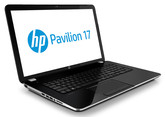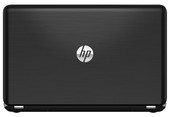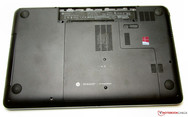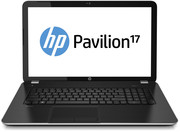Review Update HP Pavilion 17-e126sg Notebook

For the original German review, see here.
If you are looking for a gaming capable 17.3-inch all-rounder then you have a new device to consider: the Pavilion 17-e126sg. HP combines powerful processor cores with 8 GB of RAM and a big hard drive. The bundle costs about 650 Euros (~$892). Our review will reveal whether the computer can convince.
We compared the notebook to the Acer Aspire E1-772G (Core i5-4200M, GeForce 820M) and the Asus F75VC-TY088H (Core i3-2370M, GeForce GT 720M). The F75VC model reviewed by us is no longer available, but the F75VC-TY222H with Core i3-3217U processor is. Apart from the CPU, the two devices are identical. The price is about 500 Euro (~$686).
The Pavilion is not unknown to us: We already reviewed the Pavilion 17-e054sg (AMD A10-5750M, Radeon HD 8650G + HD 8670M dual graphics) model. So, we will not discuss case, connectivity, input devices and speakers here unless there are differences. Please refer to the review of the Pavilion 17-e054sg for these aspects.
Case & Connectivity
Generally, the Pavilion 17-e126sg features the same case as the Pavilion 17-e054sg. But, color and surface texture are different. The Pavilion 17-e126sg's lid and the upper side of the base unit are black and have brushed lines. The Pavilion's 17-e054g lid is bright silver gray with dark dots. The upper-side of the base unit is made from black plastic with imprinted bright dots.
Display
HP equipped the Pavilion with a glossy 17.3-inch display with a native resolution of 1600x900 pixels. Its average brightness of 198.3 cd/m² is mid-range. The display of the F75VC (213.8 cd/m²; HD+) performs slightly better. Neither competitor can keep up with the very good values of the Aspire's display (321.7 cd/m²; Full HD). The Pavilion performs better in contrast (765:1) and black value (0.26 cd/m²). The display can achieve good values here. The same is true for the Aspire (757:1, 0.44 cd/m²). The F75VC (236:1, 0.95 cd/m²) comes in last again.
| |||||||||||||||||||||||||
Brightness Distribution: 90 %
Center on Battery: 199 cd/m²
Contrast: 765:1 (Black: 0.26 cd/m²)
ΔE ColorChecker Calman: 8.39 | ∀{0.5-29.43 Ø4.77}
ΔE Greyscale Calman: 10.03 | ∀{0.09-98 Ø5}
47.5% AdobeRGB 1998 (Argyll 1.6.3 3D)
52.9% AdobeRGB 1998 (Argyll 3D)
74% sRGB (Argyll 3D)
51.3% Display P3 (Argyll 3D)
Gamma: 2.58
CCT: 12200 K
In factory state, the average DeltaE-2000 deviation of the display is 8.39 and so better than most of the displays tested by us. No color reached the target range (DeltaE smaller than 3). In addition, the display is bluish and it cannot cover either sRGB or AdobeRGB. The coverage is about 63.8% (sRGB) and 47.5% (AdobeRGB).
Although the Pavilion 17-e126sg features a different display than the Pavilion 17-e054sg, both displays are on par in outdoor capability and viewing angles. It is possible to use the Pavilion outdoors, but the environment should not be too bright. In addition, you should avoid reflections. The viewing angles are typical for cheap notebooks: In vertical direction, the image quickly changes, while the viewing angles are wider in horizontal direction. Several people can look at the screen simultaneously.
Performance
The Pavilion 17 is a cheap 17.3-inch all-round notebook. Apart from everyday tasks like surfing, Skype, writing etc., the notebook can also run current computer games - at least to some extent. Currently, our test model costs about 650 Euros (~$892). HP offers many other Pavilion 17 models. These are either equipped with Intel or AMD hardware. At the time of writing, the HP Pavilion 17-e068sg (Pentium 2020M CPU, 4 GB of RAM, 500 GB hard drive, no Windows OS) is the cheapest model for about 350 Euros (~$480).
Processor
HP equipped the Pavilion with a Core i5-4200M processor from Intel. It is based on the current Haswell architecture and features two cores. The base clock rate is 2.5 GHz. The Turbo can increase the clock rate to up to 3 GHz (both cores) or 3.1 GHz (single core). The TDP of the CPU is 37 Watt.
The full performance is available in mains operation as well as on battery. The CPU test of the Cinebench benchmarks proved that the processor runs at full speed. The Aspire achieves the same results since it is equipped with the same processor. The F75VC performs worse, because it is equipped with a weaker Core i3 processor.
| Cinebench R11.5 - CPU Single 64Bit (sort by value) | |
| HP Pavilion 17-e126sg | |
| HP Pavilion 17-e054sg | |
| Asus F75VC-TY088H | |
| Acer Aspire E1-772G 54208G1TMnsk | |
| Lenovo G710 59397112 | |
| Cinebench R11.5 - CPU Multi 64Bit (sort by value) | |
| HP Pavilion 17-e126sg | |
| HP Pavilion 17-e054sg | |
| Asus F75VC-TY088H | |
| Acer Aspire E1-772G 54208G1TMnsk | |
| Lenovo G710 59397112 | |
System Performance
The system runs smoothly. We could not observe any problems. The subjective impression is also reflected by a very good PCMark 7 result. Neither the Aspire nor the F75VC could keep up with our test model here. We are surprised that the Aspire cannot, since it is quite similarly equipped as the Pavilion. We think the HP might perform better because its RAM works in dual-channel mode.
| PCMark 7 Score | 2953 points | |
Help | ||
Storage Solution
The Pavilion comes with a hard drive from Toshiba with a capacity of 750 GB and a revolution speed of 5400 rpm. CrystalDiskMark reports a read rate of 106.2 MB/s. HD Tune displays an average transfer rate of 102.6 MB/s. This is a good value for a 5400 rpm hard drive.
Graphics Card
The Pavilion houses two graphics cards: Intel's HD Graphics 4600 graphics core and the AMD Radeon HD 8670M GPU. They are an Enduro group (AMD's counterpart to Nvidia's Optimus technology). The Radeon core is used during demanding applications like computer games. The Intel chip is active during everyday tasks and on battery. Application profiles specify which GPU is used for an application. The user can change the pre-setting in the driver menu any time. The Radeon GPU belongs to the lower mid-range. It supports DirectX 11.1 and works with a base clock of 775 MHz. With Turbo, the clock rate can be increased to up to 975 MHz.
In the 3DMark benchmarks, the Aspire and the Pavilion achieve rather similar results. The F75VC performs significantly worse than the competitors. However, this is not primarily because of weaker hardware, but because the GPU cannot completely use its Turbo.
| 3DMark 11 Performance | 1542 points | |
| 3DMark Ice Storm Standard Score | 51825 points | |
| 3DMark Cloud Gate Standard Score | 4414 points | |
| 3DMark Fire Strike Score | 811 points | |
Help | ||
| HP Pavilion 17-e126sg Radeon HD 8670M, 4200M, TOSHIBA MQ01ABD075 | Acer Aspire E1-772G 54208G1TMnsk GeForce 820M, 4200M, WDC Scorpio Blue WD10JPVX-22JC3T0 | Asus F75VC-TY088H GeForce GT 720M, 2370M, Hitachi Travelstar Z5K500 HTS545050A7E380 | HP Pavilion 17-e054sg Radeon HD 8650G + HD 8670M Dual Graphics, A10-5750M, Toshiba MQ01ABD100 | Acer Aspire V3-772G-747A321 GeForce GTX 760M, 4702MQ, Toshiba HG5d THNSNH256GMCT | |
|---|---|---|---|---|---|
| 3DMark | -1% | -17% | -9% | 116% | |
| 1280x720 Ice Storm Standard Score (Points) | 51825 | 43697 -16% | 40758 -21% | 45586 -12% | 79494 53% |
| 1280x720 Cloud Gate Standard Score (Points) | 4414 | 4955 12% | 3819 -13% | 4343 -2% | 11171 153% |
| 1920x1080 Fire Strike Score (Points) | 811 | 819 1% | 668 -18% | 696 -14% | 1971 143% |
Gaming Performance
The Pavilion can run most computer games smoothly in low resolution and low quality settings. Several games can also be played with higher resolutions or quality settings - e. g. FIFA 14. While the Pavilion was on par with the Aspire in the 3DMark benchmarks, it has to give in to the Aspire in computer game performance. So, the Aspire is preferable, if you want to occasionally play games. If the gaming performance of the Aspire does not meet your demands, Acer offers an alternative: The Aspire V3-772G features a Core i5-4200M processor and a GeForce GTX 760M graphics card for currently about 700 Euros (~$961). Windows OS is not included.
| low | med. | high | ultra | |
|---|---|---|---|---|
| The Elder Scrolls V: Skyrim (2011) | 39.8 | 26.2 | 17.4 | |
| Tomb Raider (2013) | 53 | 27.8 | 17.8 | |
| Saints Row IV (2013) | 38 | 30 | 11.6 | |
| Fifa 14 (2013) | 96.6 |
| HP Pavilion 17-e126sg Radeon HD 8670M, 4200M, TOSHIBA MQ01ABD075 | Acer Aspire E1-772G 54208G1TMnsk GeForce 820M, 4200M, WDC Scorpio Blue WD10JPVX-22JC3T0 | Asus F75VC-TY088H GeForce GT 720M, 2370M, Hitachi Travelstar Z5K500 HTS545050A7E380 | HP Pavilion 17-e054sg Radeon HD 8650G + HD 8670M Dual Graphics, A10-5750M, Toshiba MQ01ABD100 | Acer Aspire V3-772G-747A321 GeForce GTX 760M, 4702MQ, Toshiba HG5d THNSNH256GMCT | |
|---|---|---|---|---|---|
| Tomb Raider | 35% | 9% | 105% | 261% | |
| 1024x768 Low Preset (fps) | 53 | 77.5 46% | 62.8 18% | 98.7 86% | |
| 1366x768 Normal Preset AA:FX AF:4x (fps) | 27.8 | 37.9 36% | 31.1 12% | 59.2 113% | 99 256% |
| 1366x768 High Preset AA:FX AF:8x (fps) | 17.8 | 21.7 22% | 17.3 -3% | 38.3 115% | 65 265% |
Emissions
System Noise
Noise level
| Idle |
| 32.1 / 32.1 / 33 dB(A) |
| HDD |
| 32.5 dB(A) |
| DVD |
| 38.2 / dB(A) |
| Load |
| 36.2 / 39.8 dB(A) |
 | ||
30 dB silent 40 dB(A) audible 50 dB(A) loud |
||
min: | ||
Temperature
While idle, the three devices in our comparison hardly get warmer: The temperatures are in the green at all measurement points. Under load the temperatures increase moderately. All three computers exceed 40 °C in at least one measurement point.
In mains operation and on battery, the notebook runs the stress test (Prime95 and Furmark run for at least one hour) in the same way: CPU and GPU always work at their maximum clock rate (CPU: 3 GHz, GPU: 975 GHz). The CPU temperature hovers at around 80/81 °C during the stress test (in mains operation).
(±) The maximum temperature on the upper side is 40.8 °C / 105 F, compared to the average of 36.9 °C / 98 F, ranging from 21.1 to 71 °C for the class Multimedia.
(±) The bottom heats up to a maximum of 42.1 °C / 108 F, compared to the average of 39.2 °C / 103 F
(+) In idle usage, the average temperature for the upper side is 26.7 °C / 80 F, compared to the device average of 31.3 °C / 88 F.
(+) The palmrests and touchpad are cooler than skin temperature with a maximum of 31.6 °C / 88.9 F and are therefore cool to the touch.
(-) The average temperature of the palmrest area of similar devices was 28.7 °C / 83.7 F (-2.9 °C / -5.2 F).
Energy Management
Power Consumption
While idle, the Pavilion is rather frugal with values between 6.2 and 9.6 Watt. The Aspire (9.5 to 15.7 Watt) and the F75VC (8.3 to 12.9 Watt) are significantly more power hungry. The Pavilion also proved to be the most frugal under medium load (3DMark06) and full load (stress test: Prime95 and Furmark) with 37.3 and 65.4 Watt (Aspire: 70.1 and 73.1 Watt; F75VC: 57.1 and 69.7 Watt).
| Off / Standby | |
| Idle | |
| Load |
|
Key:
min: | |
Battery Life
Our realistic WLAN test automatically loads websites in 40-second intervals. The energy saving profile is selected and the display brightness is set to about 150 cd/m². The Pavilion achieves a battery life of 4:03 h. The Aspire's (3:57 h) and the F75VC's (4:49 h) are only slightly shorter. Overall, the battery lives of the three devices are very favorable.
Verdict
The HP Pavilion 17-e126sg scores points with its good system performance and a gaming performance which should at least satisfy occasional gamers. Mostly, the notebook works quietly and does not get especially warm. In addition, the storage capacity is big. The display does not belong to the best facets of the computer. It is only averagely bright and bluish. The warranty period of 12 months is too short. We would have expected 24 months.
The Acer Aspire E1-772G features a matte, bright, contrast-rich Full HD display. In addition, its gaming performance is better than the Pavilion's and it comes with a 1TB hard drive and a free mSATA slot. Furthermore, it is cheaper than the Pavilion with a price of 600 Euros (~$823). However, the Aspire comes without Windows OS. It is generally difficult for the Pavilion to compete with the Aspire. The Acer simply offers more for the money. The Asus F75VC stands out with a low price: You will get an all-round notebook including Windows 8 for 500 Euros (~$686), which performs well in most application scenarios.












